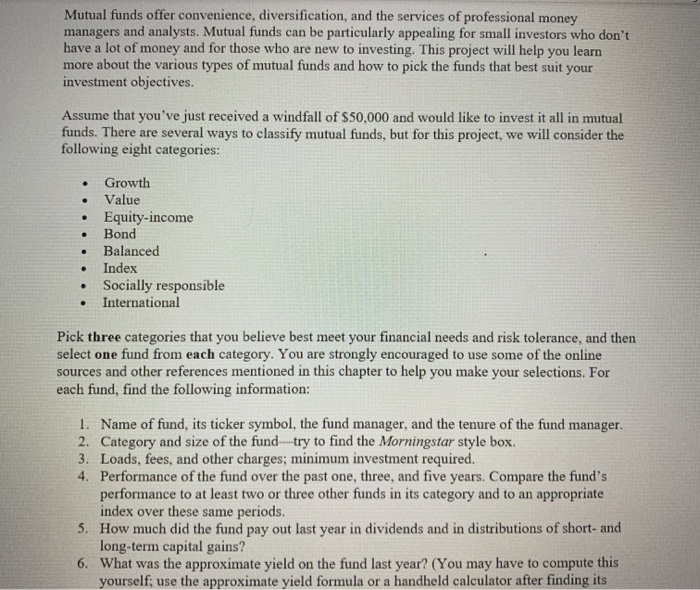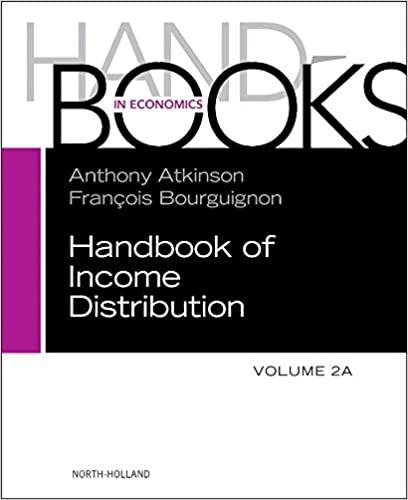Mutual funds offer convenience, diversification, and the services of professional money managers and analysts. Mutual funds can be particularly appealing for small investors who don't have a lot of money and for those who are new to investing. This project will help you learn more about the various types of mutual funds and how to pick the funds that best suit your investment objectives. Assume that you've just received a windfall of $50,000 and would like to invest it all in mutual funds. There are several ways to classify mutual funds, but for this project, we will consider the following eight categories: . . Growth Value Equity-income Bond Balanced Index Socially responsible International . . . Pick three categories that you believe best meet your financial needs and risk tolerance, and then select one fund from each category. You are strongly encouraged to use some of the online sources and other references mentioned in this chapter to help you make your selections. For each fund, find the following information: 1. Name of fund, its ticker symbol, the fund manager, and the tenure of the fund manager. 2. Category and size of the fund try to find the Morningstar style box. 3. Loads, fees, and other charges; minimum investment required. 4. Performance of the fund over the past one, three, and five years. Compare the fund's performance to at least two or three other funds in its category and to an appropriate index over these same periods. 5. How much did the fund pay out last year in dividends and in distributions of short-and long-term capital gains? 6. What was the approximate yield on the fund last year? (You may have to compute this yourself; use the approximate yield formula or a handheld calculator after finding its 5. How much did the fund pay out last year in dividends and in distributions of short-and long-term capital gains? 6. What was the approximate yield on the fund last year? (You may have to compute this yourself, use the approximate yield formula or a handheld calculator after finding its price one year ago from a source such as http://finance.yahoo.com.) 7. What services does the fund offer, such as automatic reinvestment plans or phone switching? 8. Briefly explain why you selected the fund and how it meets your investment objectives. Fund 1: Fund 2: Fund 3: Mutual funds offer convenience, diversification, and the services of professional money managers and analysts. Mutual funds can be particularly appealing for small investors who don't have a lot of money and for those who are new to investing. This project will help you learn more about the various types of mutual funds and how to pick the funds that best suit your investment objectives. Assume that you've just received a windfall of $50,000 and would like to invest it all in mutual funds. There are several ways to classify mutual funds, but for this project, we will consider the following eight categories: . . Growth Value Equity-income Bond Balanced Index Socially responsible International . . . Pick three categories that you believe best meet your financial needs and risk tolerance, and then select one fund from each category. You are strongly encouraged to use some of the online sources and other references mentioned in this chapter to help you make your selections. For each fund, find the following information: 1. Name of fund, its ticker symbol, the fund manager, and the tenure of the fund manager. 2. Category and size of the fund try to find the Morningstar style box. 3. Loads, fees, and other charges; minimum investment required. 4. Performance of the fund over the past one, three, and five years. Compare the fund's performance to at least two or three other funds in its category and to an appropriate index over these same periods. 5. How much did the fund pay out last year in dividends and in distributions of short-and long-term capital gains? 6. What was the approximate yield on the fund last year? (You may have to compute this yourself; use the approximate yield formula or a handheld calculator after finding its 5. How much did the fund pay out last year in dividends and in distributions of short-and long-term capital gains? 6. What was the approximate yield on the fund last year? (You may have to compute this yourself, use the approximate yield formula or a handheld calculator after finding its price one year ago from a source such as http://finance.yahoo.com.) 7. What services does the fund offer, such as automatic reinvestment plans or phone switching? 8. Briefly explain why you selected the fund and how it meets your investment objectives. Fund 1: Fund 2: Fund 3








